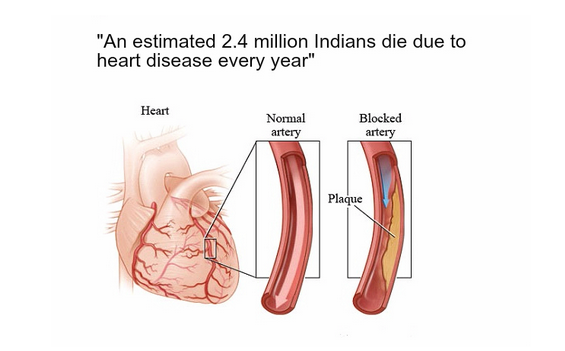 Changing lifestyles and eating habits have led to a spur in the number of heart patients globally. According to recent data for India alone, approximately 30 percent of the urban population and 15 percent of the rural population suffer from high blood pressure and heart attacks. “An estimated 2.4 million Indians die due to heart disease every year” according to Mr. K.K. Aggarwal, president of the Heart Care Foundation of India.
Changing lifestyles and eating habits have led to a spur in the number of heart patients globally. According to recent data for India alone, approximately 30 percent of the urban population and 15 percent of the rural population suffer from high blood pressure and heart attacks. “An estimated 2.4 million Indians die due to heart disease every year” according to Mr. K.K. Aggarwal, president of the Heart Care Foundation of India.
Though treatment options such as angioplasty or open heart surgery are sure shot methods to cure heart blockage, they remain expensive, painful and surgical.
Chelation therapy is an alternative method to treat coronary heart disease (heart blockage) that is administered via intravenous injections. It is based on the concept of chelation – which is more commonly used to introduce suitable chemicals into the blood stream which then chelate (or bind) to toxic metals such as lead and mercury and detoxify the body.
For about 50 years, EDTA (Ethylene Di-amine Tetra-Acetic acid), a man made amino acid is an FDA approved chemical for chelating to and detoxifying the body of lead, mercury, aluminum and cadmium poisoning. Chelation therapy reduces the need for bypass procedures as has been corroborated by the Trial to Assess Chelation Therapy (TACT) which only included people with a history of heart attacks. The trial was funded by the National Institutes of Health in 2013.
In case of heart blockage, the procedure involves infusing disodium EDTA into the blood veins of patients in a series of treatments. This chelating agent then attaches itself with the calcium which is one of the components of fatty deposits (plaques) that line the arteries, leading to blockage. Once this binding happens, the plaques are swept away along with the agent as it moves through the patient’s bloodstream. A course of chelation therapy for heart disease can require up to 30 sessions lasting several hours each, taken weekly. Usually the treatment is supported with high dosage pills of vitamins and minerals. A few side effects include burning sensation at the site of the injection, fever, headache and nausea.
The best time to begin Chelation therapy is well before your get sick. But most patients typically become interested in Chelation therapy only when they suffer from an advanced disease state and no other options are available to them.
Know more about Chelation Therapy benefits here Benefits of Chelation Therapy
Know more about our Chelation Therapy treatment here Chelation Therapy
Know more about Natural Chelation Therapy
